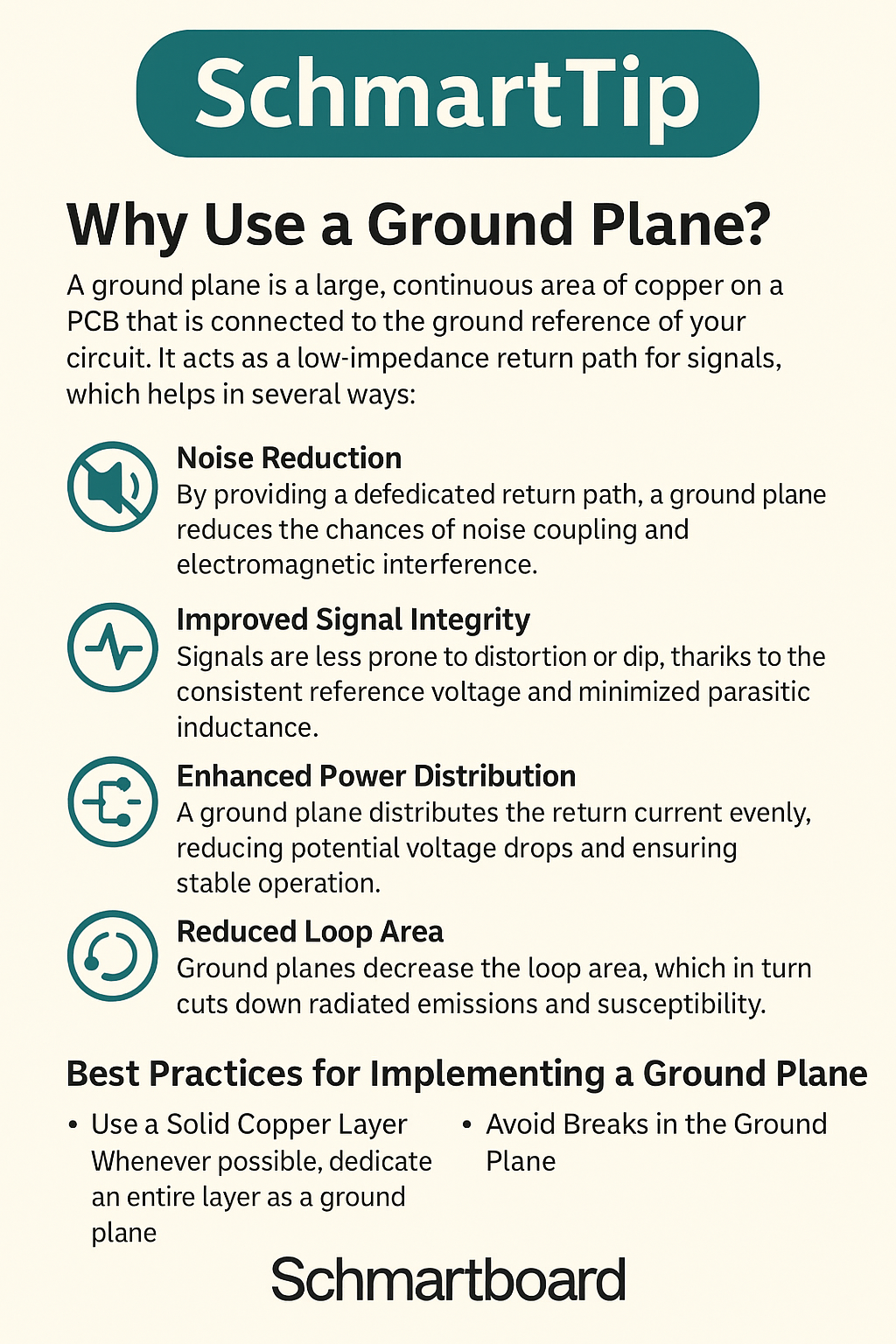 Loading... Please wait...
Loading... Please wait...Categories
Understanding the Importance of Using a Ground Plane to Minimize Noise in PCB Design
Posted by Schmartboard on Sep 19th 2025
When designing printed circuit boards (PCBs), there are numerous considerations that can significantly impact the performance and reliability of your circuit. One of the most vital yet often overlooked aspects is the use of a ground plane. Proper grounding strategies can reduce electromagnetic interference (EMI), minimize noise, and improve signal integrity — especially in high-frequency or sensitive analog circuits.
Why Use a Ground Plane?
A ground plane is a large, continuous area of copper on a PCB that is connected to the ground reference of your circuit. It acts as a low-impedance return path for signals, which helps in several ways:
- Noise Reduction: By providing a dedicated return path, a ground plane reduces the chances of noise coupling and electromagnetic interference.
- Improved Signal Integrity: Signals are less prone to distortion or dip, thanks to the consistent reference voltage and minimized parasitic inductance.
- Enhanced Power Distribution: A ground plane distributes the return current evenly, reducing potential voltage drops and ensuring stable operation.
- Reduced Loop Area: Ground planes decrease the loop area, which in turn cuts down radiated emissions and susceptibility.

Best Practices for Implementing a Ground Plane
- Use a Solid Copper Layer: Whenever possible, dedicate an entire layer as a ground plane. This maximizes the benefits of a continuous, unbroken copper area.
- Keep Ground and Power Separations Clear: While a ground plane is crucial, also maintain separation from noisy signals, high-current traces, and digital lines to reduce coupling.
- Connect Ground Points Strategically: Use multiple vias to connect the ground plane to different parts of the circuit, minimizing ground loops and potential noise sources.
- Avoid Breaks in the Ground Plane: Breaks or splits can introduce unintended antenna loops, which can cause noise issues.
Schmartboard
For hobbyists and professional engineers alike, working with PCB prototyping and manufacturing is made much simpler with tools like Schmartboard. Schmartboard offers pre-assembled, easy-to-use PCB solutions that facilitate rapid prototyping. Their boards often incorporate best practices, including ground planes, to ensure minimal noise and signal integrity issues.
Using a Schmartboard can help designers focus more on circuit design and less on layout intricacies, as these boards are engineered to promote reliable grounding strategies. Whether you're testing a high-speed digital design or sensitive analog circuitry, starting with a well-designed PCB that emphasizes solid grounding—such as those from Schmartboard—can make a significant difference in your project's success.
Final Thoughts
Incorporating a ground plane into your PCB design is a fundamental step toward minimizing noise, improving signal integrity, and ensuring the overall stability of your circuit. It’s a straightforward yet powerful technique that pays dividends, especially in complex or high-frequency designs.
And for ease of prototyping, consider using products like Schmartboard that emphasize good grounding practices—making your development process smoother and more reliable from the outset.
Happy PCB designing!
Recent Posts
- » Do Inspect Solder Joints Under Magnification for Intermittent Issues
- » Don’t Assume Power Supplies Are Perfectly Clean
- » Do Choose the Right PCB Stack-Up Early to Support Signal Integrity
- » Do Route High-Frequency Signals with Controlled Impedance
- » Don’t Overcrowd the Board — Leave Room for Debugging
